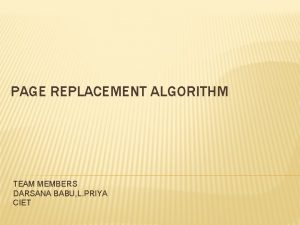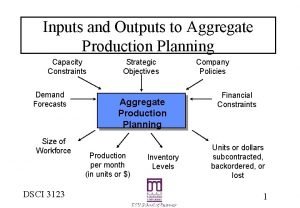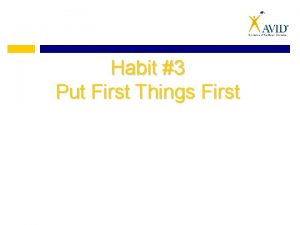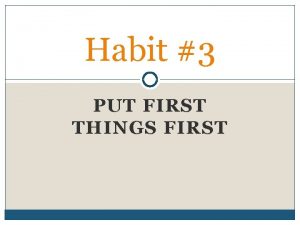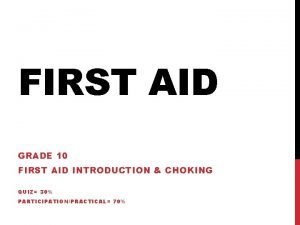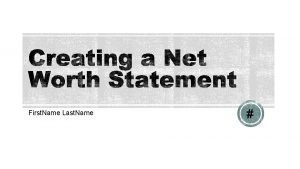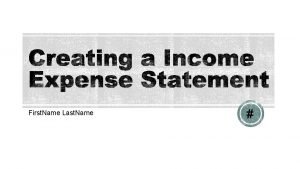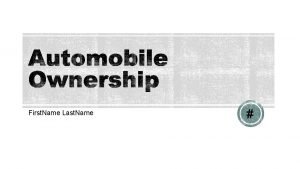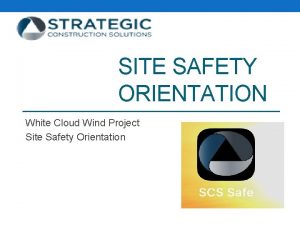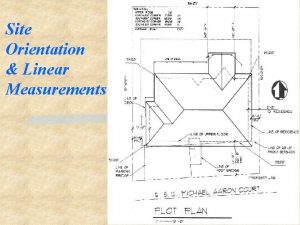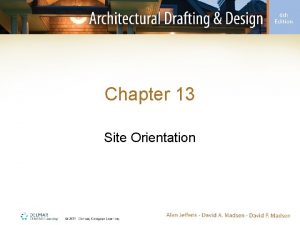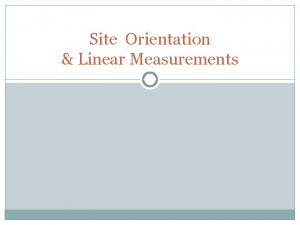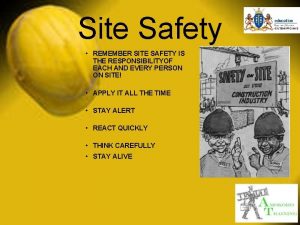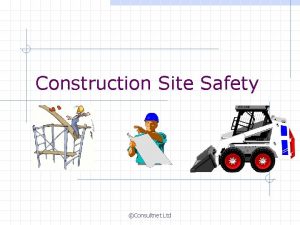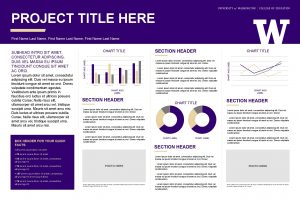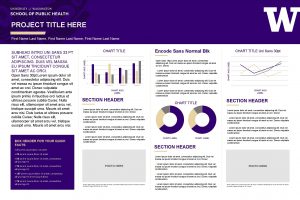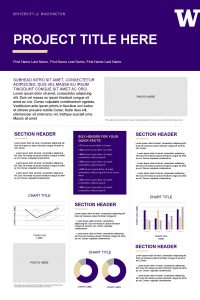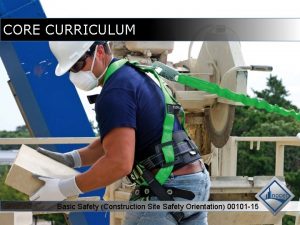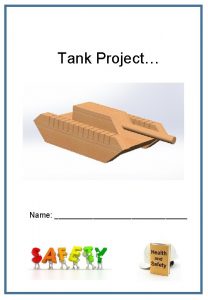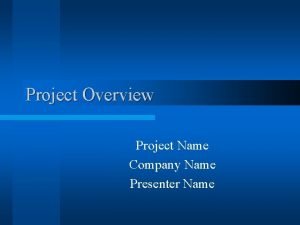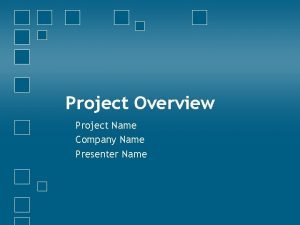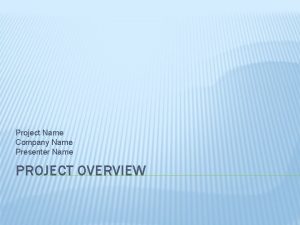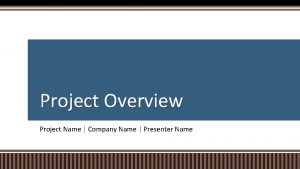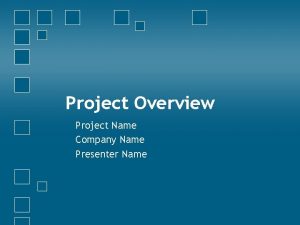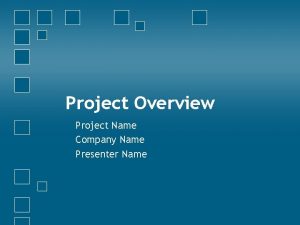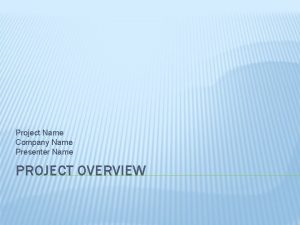SITE ORIENTATION Name of project SAFETY FIRST ORIENTATION










































- Slides: 42

SITE ORIENTATION Name of project SAFETY FIRST

ORIENTATION OBJECTIVES / SCOPE / DURATION OBJECTIVES: q. We will explain our commitment to safety. q. You will learn Safety and Loss Prevention principles and values. q. You will learn our Site Safety Policies and Procedures. SCOPE OF WORK: q. Mechanical Piping & Electrical installation 2

PROJECT H. S. E COMMITMENT / GOALS / RECORDS H. S. E COMMITMENT: AT NO TIME WILL DCM COMPROMISE THE HEALTH AND SAFETY OF ITS EMPLOYEES, AND DCM WILL ALWAYS SEEK BUSINESS SOLUTIONS THAT RECOGNIZE AND RESPECT THE ENVIRONMENT. GOALS: q ZERO Injuries q ZERO Occupational Illnesses q ZERO Releases or spills to the Environment q ZERO Adverse impact to the community q ZERO Process Incidents H. S. E. RECORDS: DCM tracks and records all incidents including: q NEAR MISS q FIRST AID q MEDICAL AID q LOSS TIME INJURY (LTI) REMEMBER - ALL INCIDENTS MUST BE REPORTED IMMEDIATELY TO YOUR SUPERVISOR and the HSE DEPARTMENT ! 3

Project Description. Mechanical The job requires a thorough knowledge of the load-bearing capabilities of the equipment you will use as well as an understanding of blueprints, technical instructions, rigging and the safety involved. In the course of the Mechanical work, workers are required to move, assemble and install machinery and equipment such as chutes, precision bearings, gear boxes, motors, mechanical clutches, conveyors, and tram rails, using hoists, pulleys, dollies, rollers, and trucks to construct foundations for the processing machinery. Piping T C E C J IFI O C R P PE S Read and interpret drawings, blueprints and specifications to determine layout requirements, cut openings for pipe in walls, floors and ceilings using hand or power tools or machines, select type and size of pipe required measure, cut, thread and bend pipe to required shape using hand power tools. Weld, braze, cement, solder and thread joints to join pipes and fabricate sections of piping system, Install supports, valves, piping and control systems 4

Project Description T C E C J IFI O C R P PE S Electrical Read and interpret drawings, circuit diagrams and electrical code specifications to plan wiring layouts. Install brackets and hangers to support electrical equipment for cable trays. Pull wire through conduits/trays and through holes in walls and floors. Install lighting fixtures and distribution equipment, such as switches, relays and circuit breaker panels. Gland terminate wire to components Test completion of circuits using test equipment. 5

T C E C J IFI O C R P PE S

T C E C J IFI O C R P PE S

RESPONSIBILITIES UNDER THE OH&S ACT It is EVERYONE’S RESPONSIBILITY to: q. Every worker while at work shall: take reasonable care to protect his or health and safety and the health and safety of other workers who may be affected by his or her acts or omissions; q Refrain from causing or participating in the harassment of another worker; q. Co-operate with any other person exercising a duty imposed by this Act or the regulations; and comply with this Act and the regulations. 8

Right to refuse A worker may refuse to perform any particular act or series of acts at a place of employment where the worker has reasonable grounds to believe that the act or series of acts is unusually dangerous to the worker’s health or safety or the health or safety of any other person at the place of employment. 9

HOURS OF WORK T C E C J IFI O C R P PE S q START OF SHIFT …………………. . 6: 30 AM q FIRST BREAK……………. 9: 30 AM T 0 9: 45 AM q LUNCH BREAK………………. . …… 12: 00 PM TO 12: 30 PM q SECOND BREAK…. . ………………. 3: 00 PM T 0 3: 15 PM q END OF SHIFT……………. 5: 00 PM WORKERS ARRIVING LATE OR LEAVING EARLY MUST ADVISE THERE SUPERVISOR. Call in # XXXX 10

DISCIPLINE POLICY Disciplinary Action: All disciplinary actions shall be conducted in front of a job steward. HR personnel from head office shall be informed of the problem. Project management must sign off on the disciplinary action. Disciplinary procedure of this process is as follows: Minor Incident Example: Not wearing their safety goggles or hat. q 1 st incident: Verbal notice (this must be written on disciplinary sheet) q 2 nd incident: Written notice q 3 rd incident: Discharge or possible suspension with or without pay. Serious Incident Example: Not being tied-off when required. q 1 st incident: Discharge Voluntarily compromising the life of another person or seriously injuring another person q 1 st incident: Immediate discharge 11

SUBSTANCE ABUSE POLICY q To protect the working environment, and health & safety of all employees, contractors, subcontractors, and general public q Types of Testing: Pre-access, Pre-Employment, Post-accident, Reasonable Cause, Return to Work, & Follow-up q Any person involved in any type of mobile incident/accident or a serious or potentially serious occupational injury will be tested to eliminate D&A as a cause or contributor. q Right to Refuse q Violation of any provision of this policy, may subject the employee to corrective disciplinary action, up to and including dismissal 12

PHYSICAL DEMANDS OF WORK To ensure the safety of all employees, workers must advise the employer of any physical / medical / mental conditions that may impact the worker’s ability to perform their regular duties or affect the health and safety of others. 13

EMERGENCY PROCEDURE If an Evacuation is required: 1. Stop work immediately. 2. Secure and safe area (shut down equipment, de-energize tools, turn off fuel supplies). 3. Leave work area calmly and quickly. 4. Assemble at the DCM Office/Lunch. Trailer 5. Verify head count. 6. Await further instructions. Note: Work permits are suspended until reinstated by client representative. Work will not resume until ALL CLEAR is given. Failure to comply will result in disciplinary action. 14

PERMITS AND FLHA All Work Activities require a Safe Work Permit or an FLHA q Generally, permits will be valid for duration of the shift. q All permits, regardless of the permit issuer, are automatically suspended during and emergency / evacuation situation. q All permits must be re-validated by Hatch permit issuer. q Workers will perform a field level hazard assessment (FLHA) before starting all tasks, and whenever there is a change in the task conditions. This is done at the job location. q Foreman must sign off on the FLHA before first break. 15

JOB HAZARD ANALYSIS Safety is the prevention of losses through the ongoing identification of work place hazards and the management of risks. q All job tasks will be evaluated to determine their risk. q A field work package will have the JHA, Work order, P&ID’s this will give detailed information of the job. q The JHA will help to establish the procedure. 16

Field Safety Inspection Sheet Visible Felt Leadership Supervisors need to complete one inspection sheet per week. 17

MEETINGS Daily Tool Box Talk – Daily @ 6: 30 am Sign on a meeting form that you understand your daily work plan & the safety involved. Weekly Safety meetings- Friday’s @ 09: 45 am q Review Incidents q Discuss topics q Voice concerns/receive answers to previous concerns q Announcements/alerts q Meeting minutes posted in lunchroom Note: Concerns should be immediately brought to your supervisors attention- Don’t save them 18

PERSONAL PROTECTIVE EQUIPMENT (PPE) Personal Protective Equipment is required to be worn by all personal when on site at all times except in the following areas: q Lunch Trailers q Office Complexes q Courtyard, unless you are working in this location. Basic Site PPE consists of the following: q Hard Hat q Reflective stripes q Safety Goggles/Smoggles q Gloves (at all times) q Steel Toed Safety Boots q Hearing protection over 85 decibels or where indicated Note: Any direct service providers “welders” or subcontractor must provide their own PPE 19

BARRICADES AND FLAGGING STANDARDS q Red flagging means “Danger Do Not Enter” q Yellow flagging means “CAUTION” q Both types of flagging must have a tag attached to the flagging, tags must be on all 4 sides of ribbon the tag must state; Company name, date, hazard, and contact information. q Never cross “Danger” flagging unless you are directly involved with work taking place and are authorized. q Workers must sign on to JSA and FLRA prior to entry into a red ribbon work area. q Must have verbal confirmation. q Cross “Caution” flagging only if absolutely necessary. q Flag only as much area as required. q Take down flagging immediately after your work is completed. 20

HAND PORTABLE TOOLS q Remove defective tools form work area, place a do not operate tag and write the problem on the tag return them to the tool crib. q Guards must not be removed from tools. q Do not modify or make your own tools get the proper tool for the job. q Electric tools must be grounded / double insulated. q Valid Certification is required to operate powder – actuated tools. q Whip checks and pins are required on all compressed air hoses. q Dead-man switches must be operational. q Trigger locks must be disengaged. q All sources of electrical energy are to be GFCI protected. 21

Mobile Equipment q A Valid drivers license is required and seat belts must be worn at all times. Any conflicts with licenses must be reported to safety immediately. q Speed limit on site is 30 km/h. q Use of cell phones while operating any mobile equipment is prohibited. q Mobile Equipment will be inspected prior to site entry and inspected prior to each use by the worker. Obey all traffic signs and vehicle regulations. q AWP’s and mobile equipment operator’s require competent / trained operators & must have a competency check completed by the foreman or a ticketed operator before they can operate the equipment. Competency forms are signed off by DCM safety and Hatch Lead. q All vehicles and equipment; scissor lifts included, require 20 lb ABC fire extinguishers. 22

SCAFFOLDS q Scaffolds are inspected by a qualified person, if a scaffold has an outdated tag, do not use, contact your Supervisor. q Scaffold tags are: Yellow – Use with caution – read the modifications on the tag Red – Do not use q If the scaffolding does not have a tag treat it as a Red Tag! 23

WELDING AND CUTTING OPERATIONS q Ventilation and respiratory equipment may be required for welding. q Fit testing is required prior to using respirators. q Containment of sparks and hot slag is a must. Use a fire blanket q Welding screens are required when welding flash is possible to other workers. q Ensure all cables are suspended where possible. q Flashback arrestors are required at the regulator and cutting end of OXY/ACETYLENE units. 24

CONFINED SPACES q Confined Space Entry Interpretation In this Part: (a) “confined space” means an enclosed or partially enclosed space that: (i) is not primarily designed or intended for human occupancy, except for the purpose of performing work; and (ii) has restricted means of entrance and exit; (b) “hazardous confined space” means a confined space that is or may become hazardous to a worker entering the confined space due to: (i) the design, construction or atmosphere of the confined space; (ii) the materials or substances in the confined space; (iii) the work activities or processes used in the confined space; or (iv) any other conditions relating to the confined space; (c) “isolate” means to physically interrupt or disconnect pipes, lines and sources of energy from a confined space. 25

CONFINED SPACES q Before entry into a confined space a permit is required and will detail requirements for entry. q Man Watch required. q Review of the entry permit i. e. : - Fall arrest requirements - Atmospheric testing - Required rescue procedures, etc. Approved Confined Space Monitor and Entry course must be completed before entry! 26

FALL PROTECTION q 100% tie-off is required at all times when exposed to a fall hazard greater than 10 feet. (i. e. whenever there are no guardrails and handrails). A shock absorbing double lanyard is mandatory. q A full body harness is required to be worn on scaffolding decks when indicated on the inspection tag. q 100% tie-off must be maintained on scaffolding decks or any landing 10 feet over if the plane of the guardrail is broken by reaching over the rail to perform a task. q Fall Protection training must be completed before an employee can use fall protection. 27

FALL PROTECTION When tie-off is required: q A secure anchor point or approved lifeline (5000 pounds) must be used. q Anchor slings may be used as an anchor attachment. q Full Body harness and tied-off lanyard is required in any crane – lifted man-baskets and aerial work platforms. q Two person maximum in AWP basket with materials and tools (combined weight cannot exceed 500 pounds or as indicated on the equipment). q Do not open holes in floors or roofs without prior authorization. 28

MANUAL HANDLING q Maximize “mechanical” handling and lifting. q No manual lifting shall exceed 20 kg or 44 lbs. YES q Always get help with loads that are too heavy or awkward. q Keep the front end of extended loads (ladders, pipe, etc. ) high and watch to avoid striking objects or other people. q Minimize repetitive tasks. q Use specific PPE during material handling. NO q Use correct lifting techniques during lifts. 29

HOUSEKEEPING q Good housekeeping is a basic part of safety and is everyone’s responsibility. q All work areas must be kept clean and free from obstructions at all times. q Report any substandard or unsafe conditions to your supervisor immediately – do not wait for the next safety meeting q Correct any unsafe conditions, which you are qualified, able, and authorized to safely correct. q Tie/wrap cords, and cables, approximately seven feet overhead. q Materials must not be stored in walkways or doorways. Tools not being used should be returned to the tool crib to ensure they do not become damaged. q Waste and garbage must be removed from the work location and disposed of in garbage bins. 30

ENVIRONMENTAL PROTECTION q It’s everyone’s responsibility to ensure the environment is protected. q Store and use hazardous products safely. q Dispose of waste products according to instructions and in proper bins or containment areas. q Report all spills and other environmental incidents to your supervisor IMMEADIATELY. 31

ISOLATION : MECHANICAL / ELECTRICAL LOCK OUT – TAG OUT PROCEDURE q ISOLATION IS NECESSARY TO WORK ON / OPERATE ANY LIVE ENERGIZED COMPONENTS. q ISOLATION SHALL BE DONE ACCORDING TO THE APPROVED LOCKOUT/TAGOUT PROCEDURE. q THE LOCK OUT – TAG OUT (LOTO) AND BLANKING/BLINDING PROCEDURE SHALL BE USED WHEN IT IS NOT POSSIBLE TO PHYSICALLY REMOVE A CONTINUITY ELEMENT. q EACH WORKER WILL PLACE THEIR OWN LOCK AND TAG. 32

SITE HSE HAZARD IDENTIFICATION ELECTRICAL HAZARDS – ELECTROCUTION HUMAN SENSES WILL NOT PROVIDE A WARNING OF ELECTRICAL HAZARDS !!! ABOUT 20% OF ELECTRICAL INCIDENTS (1 IN 5) ARE DIRECTLY FATAL, OR CAN CAUSE FATALITY DUE TO FALL FROM HEIGHT, FIRE, ETC. , AND IN GENERAL ARE OFTEN THE CAUSE OF SERIOUS CONSEQUENCES ALWAYS ASSUME THAT ALL ELECTRICAL LINES AND EQUIPMENT ARE ENERGIZED, AND THEREFORE HAZARDOUS UNTIL ALL COMPONENTS HAVE BEEN PROPERLY ISOLATED FROM ELECTRICAL FEEDS AND FEEDBACKS, AND HAVE BEEN GROUNDED (IF APPROPRIATE), LOCKED OUT, TAGGED, AND TESTED. 33

SITE HSE HAZARD IDENTIFICATION ELECTRICAL HAZARDS – ELECTROCUTION • Do not allow cables to lay on wet floor or in the water. • Always use proper plugs and sockets. • Protect cables form sharp edges and crushing by using “softeners”. • Do not pull the cables. • Always use low voltage. • Only a competent electrician can install, or maintain any electrical systems. • Electrical apparatus’ must be double isolated and/or grounded. • Low voltage equipment will be used whenever possible. • No repairs or alterations shall be carried out on any live equipment except where a complete disconnection of the equipment is not practicable. In “Hazardous Locations”, as defined by the Canadian Electrical Code, where explosive or flammable materials or gases are present, special precautions shall be observed: repairs or alterations shall not be made on any “live” equipment. • Electrical measurements above 300 V must use a qualified manwatch/standby back-up person 34

HAZARDOUS SUBSTANCES COMPRESSED GAS Can become projectiles if damaged TOXIC Even in very small quantities these will kill you or cause severe damage to your health OTHER TOXIC EFFECTS Can cause long term health effects such as cancer CORROSIVE Attacks and destroys living tissue incl. eyes and skin HIGHLY FLAMMABLE BIOHAZARD INFECTIOUS These substances May cause a serious can easily catch fire disease resulting in even after brief illness or death. contact with an ignition source RADIOACTIVE The material is very unstable, may react with water to release a toxic or flammable gas OXYDIZING SUBSTANCES These substances provide oxygen 35

HAZARDOUS SUBSTANCES AND MSDS READ THE MSDS BEFORE WORKING WITH ANY CHEMICAL READ ALL LABELS BEFORE YOU WORK WITH A CHEMICAL Material Safety Data Sheets are available at the Tool Crib at the safety office and in the Lunch Trailer 36

UTILIZE THE CORRECT PROTECTIVE DEVICES AS PER MSDS PERSONAL PROTECTIVE EQUIPMENT SHALL BE IN COMPLIANCE WITH MSDS REQUIREMENTS. PAY PARTICULAR ATTENTION TO POSSIBLE CONTACT WITH DANGEROUS SUBSTANCES. “CHEMICAL COVERALS, GLOVES AND BOOTS (SOMETIMES RUBBER IS REQUESTED), EYES, FACE AND RESPIRATORY PROTECTION SHALL BE CHOSEN CAREFULLY” 37

FIRE EXPLOSION HAZARDS BEWARE OF FLAMMABLE PRODUCTS ! HAZARDS q FLAMMABLE / EXPLOSIVE q HOTWORK q IGNITION SOURCES q ELECTRICAL SOURCES q COMBUSTIBLES CONTROLS q INSPECTED FIRE EXTINGUISHERS q FIREWATCH / SPARKWATCH q. EMERGENCY RESPONSE PLAN q COMMUNICATIONS q WEAR PPE 38

Occupational Health & Safety Act, Regulations & Code Fire extinguishers q Dawcolectric shall ensure that portable fire extinguishers are selected, located, inspected, maintained and tested so that the health and safety of workers at the place of employment is protected. q Dawcolectric shall ensure that portable fire extinguishers are placed not more than nine metres away from each welding or cutting operation that is in progress. 39

How to use a fire Extinguisher Fire Extinguisher Inspection: All extinguishers on site must be inspected once a month. A log of all the extinguishers will be keep in the safety office and one designed competent person will have to inspect it at the beginning of each month. When you need it: 1. All mobile equipment used on site shall be equipped with a minimum of a 20 lbs ABC fire Extinguisher. 2. As soon as you got a hot work permit to do your job, you will need an extinguisher at the job location as a precaution. So grinding, cutting, and welding will required you to carry a fire extinguisher. This extinguisher must be kept in the area where the hot work is done. Visual inspection of the fire extinguisher must be done prior to starting work. A typical fire extinguisher contains 10 seconds of extinguishing power. This could be less if it has already been partially discharged. Always read the instructions that come with the fire extinguisher and become familiarized with its parts before you will need it 40

How to use a fire Extinguisher; PASS Pull the Pin at the top of the extinguisher. The pin releases a locking mechanism and will allow you to discharge the extinguisher. Aim at the base of the fire, not the flames. This is important - in order to put out the fire, you must extinguish the fuel. Squeeze the lever slowly. This will release the extinguishing agent in the extinguisher. If the handle is released, the discharge will stop. Sweep from side to side. Using a sweeping motion, move the fire extinguisher back and forth until the fire is completely out. Operate the extinguisher from a safe distance, several feet away, and then move towards the fire once it starts to diminish. Be sure to read the instructions on your fire extinguisher- different fire extinguishers recommend operating them from different distances. Remember: Aim at the base of the fire, not at the flames!!!! If you are not able to contain the fire or you don't feel comfortable to fight it. Remain calm, call for emergency assistance and leave the area. Quick recommendation q To prevent fire, remove all flammables materials from your area prior to start your work. Use fire blanket to contain sparks and take an extra minute to plan your hot work. 41

ORIENTATION QUESTIONS ? ? ? 42
 Basic safety orientation
Basic safety orientation Basic safety orientation
Basic safety orientation Hot site cold site warm site disaster recovery
Hot site cold site warm site disaster recovery First surname
First surname Her name
Her name First name last name tpu
First name last name tpu Name a line containing point a
Name a line containing point a Inception deck template
Inception deck template Geocentric company example
Geocentric company example Employee safety orientation quiz answers
Employee safety orientation quiz answers Safety depth formula in ecdis
Safety depth formula in ecdis Safety care behavioral safety training
Safety care behavioral safety training Process safety vs personal safety
Process safety vs personal safety Ind safety report
Ind safety report Project empowerment orientation registration
Project empowerment orientation registration First robotics safety
First robotics safety Injury prevention safety and first aid
Injury prevention safety and first aid Barney safety
Barney safety One gene one enzyme hypothesis
One gene one enzyme hypothesis Site analysis and inventory
Site analysis and inventory Untangle openvpn setup
Untangle openvpn setup Internet safety project
Internet safety project Site name
Site name The maturity continuum 7 habits
The maturity continuum 7 habits Breadth first and depth first search
Breadth first and depth first search Sdl first vs code first
Sdl first vs code first Habit 3 lesson plans
Habit 3 lesson plans Put first things first meaning
Put first things first meaning Difference between code first and database first approach
Difference between code first and database first approach First to file vs first to invent
First to file vs first to invent Data structure stack
Data structure stack![Stack=[] digunakan untuk membuat stack dengan Stack=[] digunakan untuk membuat stack dengan](data:image/svg+xml,%3Csvg%20xmlns=%22http://www.w3.org/2000/svg%22%20viewBox=%220%200%20200%20200%22%3E%3C/svg%3E) Stack=[] digunakan untuk membuat stack dengan
Stack=[] digunakan untuk membuat stack dengan First in first out
First in first out First come first serve
First come first serve Put first things first definition
Put first things first definition Fcfs gantt chart
Fcfs gantt chart See do get model 7 habits
See do get model 7 habits Habit 3 put first things first
Habit 3 put first things first Put first things first video
Put first things first video Habit 3 activities
Habit 3 activities First aid merit badge first aid kit
First aid merit badge first aid kit Three ps in first aid
Three ps in first aid 7 habits promise
7 habits promise



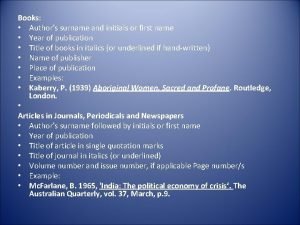



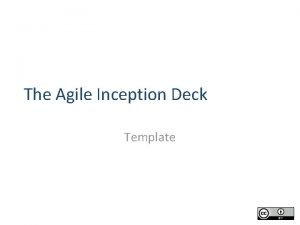

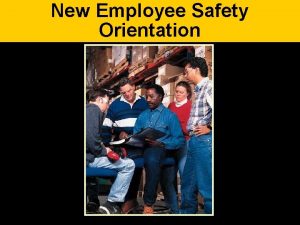




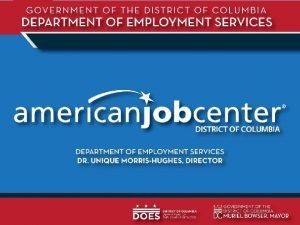
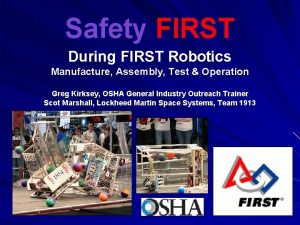

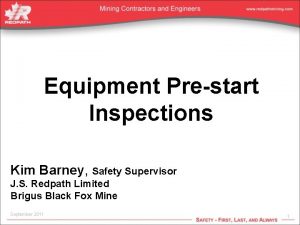
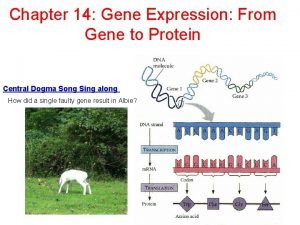
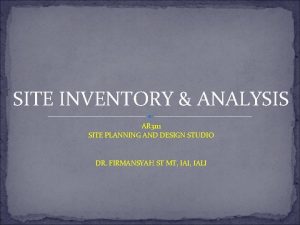

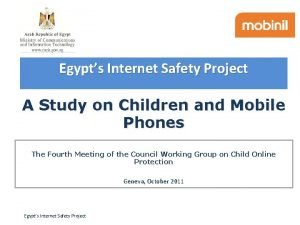
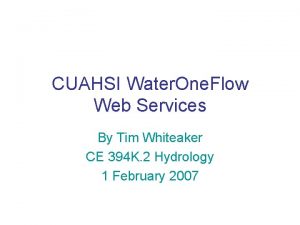


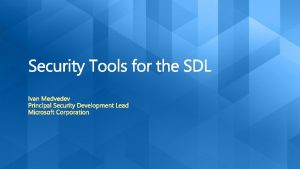



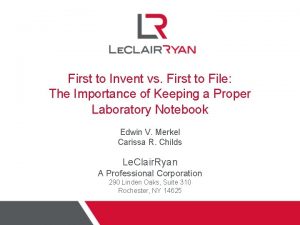
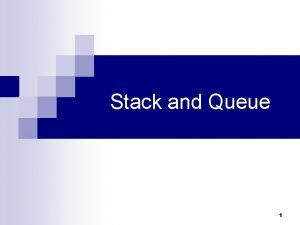
![Stack=[] digunakan untuk membuat stack dengan Stack=[] digunakan untuk membuat stack dengan](https://slidetodoc.com/wp-content/uploads/2020/10/1003988_042512bb86e3aab910dfb86ac5697e60-300x212.jpg)
